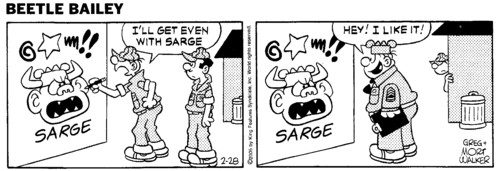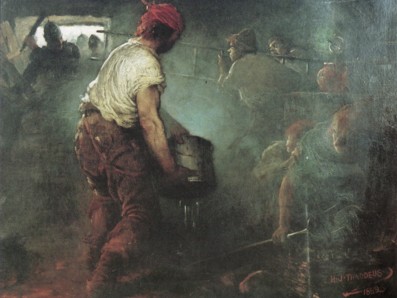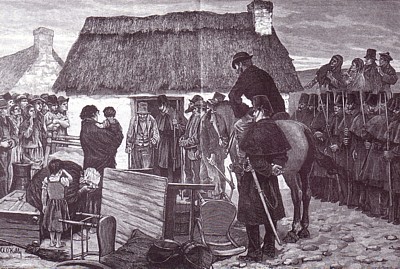|
Caoimhghin Ó Croidheáin - Notes on work Some Notes on Political Art
(2005) It is very difficult to define political art. Views on what makes art political can range from the idea that all art is political (i.e. it either implicitly supports or explicitly opposes the status quo) to pointing out, for example, the obviously political murals on walls around Belfast. As a way of narrowing the former and broadening the latter I suggest here a view of political art that uses three categories: Portrayal, Promotion, or Projection. Portrayal For the slaves, the ultimate effect of such art may be positive or negative. In a positive sense it may create group awareness and solidarity, or, in a negative sense, it could also consolidate inertia, a feeling that nothing can be done to change the situation. The art styles or movements of Realism, Social Realism and Naturalism could fit into the category of ‘Portrayal’.
Promotion Thus one view of an event, that which would encourage others or strengthen an activism already present, is promoted over images of the event that may have the opposite effect. In this case, the politics of representation takes precedence over the representation of politics. Unlike ‘Portrayal’, this type of art is harder to manipulate from an opposing point of view. The politics is generally explicit and can have a positive inspirational effect. The art styles or movements of Socialist Realism and ‘Political Art’ (e.g. murals, banners, posters etc.) and Social Realism to a certain extent could fit into the category of ‘Promotion’.
Eviction Scene Henry Jones Thaddeus (1889) [source History Ireland] [In this painting above the artist represents an eviction scene from inside the house as the occupants try to deal with the fire and defend themselves from the police. The 'politics of representation' may be seen here in the compositional dominance given to the defenders and the very small area given over to the intruding police. The type of view we are more familiar with is of the landlord, police and passive onlookers dominating the scene from outside the house - compare eviction scene below.]
Eviction in the West of Ireland Aloysius O'Kelly (1881) [source History Ireland] Projection
For example, a picture showing the Rock of Cashel (ancient fortress in Co. Tipperary, Ireland) with a Japanese Shinkansen bullet train speeding by may be a jarring conjunction of images but suggests the possibility of a super fast transport system in Ireland. Therefore it has social and economic implications for the Irish State which in turn makes it implicitly political. However, like in the first category Portrayal, opposing political viewpoints can claim this image for their vision of the future. The same scene would be explicitly political though, if, for example, ‘Workers of the world unite’ was written on the side of the Shinkansen. Thus it can be seen from the above categories that the representation of particular actions or the inclusion of particular types of text ties an image down to an explicitly political perspective. The past, present and future, with some overlapping, are also covered in this way of seeing or defining political art. (Any comments on the above
Notes are very welcome.)
|


